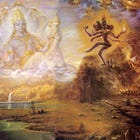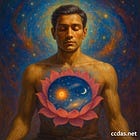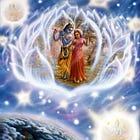Questions about the mysterious “fall” of Jaya and Vijaya from Vaikuṇṭha
When we study this pastime, we may end with many unanswered questions. How could someone from the material world come and forcefully drag down two eternal associates of the Lord out of Vaikunta?
Jaya and Vijaya are eternal servitors of the Lord, but at the same time, they committed a mistake in stopping the four Kumāras at the gates of Vaikuṇṭha when they wanted to see the Lord. That was unprecedented. How could someone from the material world come and forcefully drag down two eternal associates of the Lord out of Vaikuṇṭha?
When we study this pastime, we may end the reading with many unanswered questions. Here are some questions about this mysterious pastime and their answers.
a) The pastime of Jaya and Vijaya is yet another alert for the dangers of performing Vaishnava aparadha. If even Jaya and Vijaya had to come to the material world and spend three lives here as a result of offending the four Kumaras, we can only speculate how precarious will be our situation if we do the same. Although devotional service is eternal and can’t be ever destroyed, offenses to other devotees can cover it for a long time, resulting in a very unpleasant trip to the dungeons of material existence.
b) How the four Kumaras could become angry and curse Jaya and Vijaya. This is answered in SB 3.16.25, where Prabhupada explains that the Kumaras were influenced by the modes of passion and ignorance:
“The cursing of Jaya and Vijaya is here repented. Now the Kumāras are thinking in terms of their position in the modes of passion and ignorance, and they are prepared to accept any kind of punishment from the Lord.”
c) This raises yet another question: are the Vaikunta planets not supposed to be free from the influence of the material modes? This is answered in further purports.
At that point, the Kumaras were still attracted to the impersonal feature of the absolute truth, and therefore they were not completely free from the influence of the material modes. Sometimes the Lord organizes for beings from the material world to visit the Vaikuntha-lokas for some purpose, like in the case of Durvasa Muni (who went all the way to Vaikunta just to be scolded by the Lord and told to go back and beg forgiveness from Ambarisha Maharaja) and the four Kumaras. Because they are not ready yet to stay in Vaikunta, they go back after their visit. In the case of the Kumaras is also mentioned that they did not enter Vaikuntha-loka: they went up to the last door and from there returned to the material world, after getting the darshan of Lord Vishnu.
d) It becomes easier to understand when we consider the possibility that they may have gone to Vaikunta through Śvetadvīpa. Normally, to reach the Vaikunta planets, one has to pass through the abode of Lord Shiva, the light of the impersonal Brahmajoti, and so on, realms that are already free from the influence of the material modes. In other words, one would have to be free from the influence of the material modes much before reaching the doors of the spiritual planets, having passed through all these different abodes.
The possibility that the Kumaras have gone thorough Śvetadvīpa, however, can explain this apparent contradiction, since in this case there is a clear border between the material and spiritual words. Beyond the door protected by Jaya and Vijaya, there was Vaikunta, a place free from the influence of the material modes, but the Kumaras didn’t cross the door. Thus, they were still on the material side, and could thus still be influenced by the material modes.
e) Another point is that the whole incident happened due to the will of the Lord. It is described in the Laghu Bhagavatamrta that being the two strongest doorkeepers of the Lord, Jaya and Vijaya had the desire to serve the Lord by fighting with Him, and at the same time, the Lord Himself wanted to fight, and this desire could only be satisfied by some of his associates coming to the material world and playing the role of enemies. The anger propensity of the Kumaras was thus used by Lord Vishnu to fulfill both purposes.
f) A final question could be if this pastime of Jaya and Vijaya being cursed and “falling” from Vaikunta is repeated in every Kalpa, with them repeatedly playing the roles of demons and fighting the Lord. In the Laghu Bhagavatamrta (1.5.50), Srila Rupa Goswami answers that no. The incarnations of Jaya and Vijaya as Hiranyakashipu and Hiranyaksa happened only in this particular universe, coinciding with the curse of the Four Kumaras. In other words, that’s a special occurrence. In other universes, as well as in other Kalpas, Lord Nrsinhadeva and Lord Varaha fight with regular demons.
Some conclusions
We can thus conclude that:
1- Jaya and Vijaya faced a temporary reaction by accidentally offending the Kumaras.
2- This was the will of the Lord. Therefore, they were not pushed out of the Vaikuntas by an external force, nor by the influence of the three modes.
3- They never fell, since they remained connected with the Lord through constantly meditating on Him in anger. The three lives they spent in the material world are equal to just a blip of time in Vaikuntas, therefore practically speaking they never left.
4- Just like Jaya and Vijaya, other associates of the Lord frequently come to this material world for different purposes. These are not fall downs.
5- The whole incident serves as an example of the dangers of offending other devotees. Although never failing from their eternal positions, Jaya and Vijaya had to face a temporary reaction.
6- The “falling” of Jaya and Vijaya is a special occurrence and not a regular pastime that repeats at every Kalpa.
One could be tempted to use the story of Jaya and Vijaya as a support to the idea that souls fall regularly from the spiritual world, or conversely, that we were never with Krsna, since no one falls from the spiritual world. However, this story doesn’t support either side. The situation of Jaya and Vijaya is different from ours because they never forgot about Lord Vishnu, and thus remained connected with Him. Jaya and Vijaya came for three lives just to assist the Lord in His pastimes, while we have been forgetful of the Lord since time immemorial.
The whole discussion about the fall or no fall of the soul is largely misguided, and mostly based on intellectual pursuits, personal opinions, dogmas, and emotions. Srila Prabhupada alerts us that this is an extremely intricate philosophical question, that is essentially impossible to understand while we are still in the material world and thus subjected to the influence of material modes, material time, and so on.
In his teachings, Srila Prabhupada gives a much more nuanced understanding of this topic than most of us can grasp, emphasizing that every soul has an eternal relationship with Krsna and that every soul has intrinsic love for Krsna that can’t be ever lost, although it can be temporarily forgotten. He offers the analogy of a dream to explain it, an analogy that is easy to understand, since a dreaming person may experience many different situations, although he never leaves his bed. In this way, Prabhupada harmonizes the idea that the soul has an eternal relationship with Krsna and intrinsic love for Krsna, the idea that no one falls from the spiritual world, and the fact that we are here.
Ultimately, however, this is a great mystery that even Sri Caitanya Mahāprabhu Himself didn’t try to directly explain. Instead, He prayed: “O son of Maharaja Nanda (Krsna), I am Your eternal servitor, yet somehow or other I have fallen into the ocean of birth and death. Please pick me up from this ocean of death and place me as one of the atoms at Your lotus feet.” (Siksastakan 5)
“Somehow or other” we came to this material world, but this doesn’t matter, since now our goal is to come out of this ocean and regain our eternal spiritual position as Krsna’s servants. As Srila Prabhupada explains, if a person falls into the ocean, his immediate problem is how to save himself. After he is out of the ocean, in a safe situation, he may calmly sit and enquire about the reasons for his falling into the ocean.
As he wrote in his translation to CC Madhya 22.107: “Pure love for Kṛṣṇa is eternally established in the hearts of the living entities. It is not something to be gained from another source. When the heart is purified by hearing and chanting, this love naturally awakens.”
This is more thoroughly explained in his purport to CC Adi 7.142:
“By the practice of devotional service, beginning with hearing and chanting, the impure heart of a conditioned soul is purified, and thus he can understand his eternal relationship with the Supreme Personality of Godhead. That eternal relationship is described by Śrī Caitanya Mahāprabhu: jīvera ‘svarūpa’ haya kṛṣṇera ‘nitya-dāsa.’ “The living entity is an eternal servitor of the Supreme Personality of Godhead.” When one is convinced about this relationship, which is called sambandha, he then acts accordingly. That is called abhidheya. The next step is prayojana-siddhi, or fulfillment of the ultimate goal of one’s life. If one can understand his relationship with the Supreme Personality of Godhead and act accordingly, automatically his mission in life is fulfilled.”
Read also:






Hare Krishna Prabhu ji 🙏 Thank you so much for addressing most frequent question, your article clarifies everything. Love reading your articles. I wait everyday for your article, to read something interesting and informative. Haribol.
Prabhuji but I still didn't understand the statement I asked in one of the recently past comment about the statement "pāya bhakti-latā-bīja"